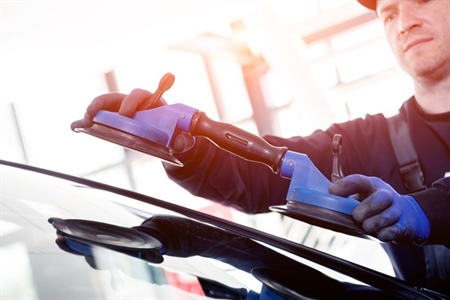How Long Should You Wait Before Driving After a Windshield Replacement?

Waiting the right amount of time before you take your car out on the road after a windshield replacement is critical for your safety and the integrity of the bond that holds your glass in place.
At Glasswerks, we understand that getting behind the wheel too soon can compromise the strength of the adhesive used during your windshield replacement, while waiting too long can leave you sidelined when you need your vehicle most.
Whether you’ve just had a chip grow into a crack or your windshield was damaged beyond repair, knowing how and why adhesives cure the way they do will help you plan your drive with confidence.
Here's what you need to know about adhesives, curing times, and when it's safe to start driving after a windshield replacement.
Factors That Influence Windshield Replacement Adhesive Curing Time
Adhesive chemistry plays a primary role in determining cure rate.
Most windshield installations use polyurethane-based urethane adhesives that cure through moisture absorption.
Higher-quality formulations from OEM-approved suppliers feature additives that balance initial tack with controlled cure speed.
Surface preparation affects bonding consistency. Technicians must remove old adhesive, clean the pinch weld, and apply primer.
A uniform primer coat promotes even curing; any contamination can create cold spots that slow the reaction between the adhesive and ambient moisture.
Ambient conditions such as temperature, humidity and air flow dictate molecular crosslinking speed.
Cooler, arid environments extend cure times, while warm, humid conditions accelerate them.
At GlassWerks, our technicians account for local climate to recommend safe drive-away times after windshield replacement.
Strategies to Accelerate Windshield Adhesive Drying
Controlled heat application can shorten cure time by increasing moisture diffusion into the adhesive bead.
Heated curing lamps or warm-air blowers raise the pinch-weld temperature into the optimal 75–85°F range without exceeding manufacturer limits. This method is common in mobile service vans equipped for rapid turnarounds.
Maintaining relative humidity between 40% and 60% ensures urethane adhesives have adequate moisture to crosslink. Portable humidifiers in enclosed bays help stabilize humidity when outdoor levels drop below 30%. Technicians avoid over-saturation, which can weaken the bond.
Using OEM-specified accelerators blended into the primer can reduce tack adjustment time without compromising final strength.
These accelerators modify the polymer network to achieve handling strength sooner, allowing safe movement of the vehicle in as little as 60 minutes under ideal conditions.
Precautions to Take Immediately After Windshield Installation
Avoid slamming doors or applying lateral pressure near the windshield for at least two hours to prevent bond shifting. Any stress on the bead before it gains handling strength may introduce micro-gaps, risking water intrusion or bond failure.
Keep the vehicle in a sheltered area, ideally a climate-controlled bay or garage. Exposure to wind, direct sunlight or inclement weather before the adhesive sets can cause uneven curing and surface defects.
Refrain from high-pressure car washes and automated cleaning systems for at least 24 hours after installation. Even once handling strength is achieved, excessive water pressure can exploit unbonded edges and compromise seal integrity.
Impact of Weather on Windshield Adhesive Curing Time
Cold temperatures below 50°F can double standard cure durations, as polymer crosslinking reactions slow. In winter climates, technicians may schedule installations during midday when ambient temperatures are highest.
High humidity accelerates moisture-curing adhesives but can lead to surface tackiness if levels exceed 80%. Glasswerks recommends balanced humidity to prevent outgassing and ensure a clean, smooth bead profile.
Rain and direct exposure to UV rays immediately after installation can affect the surface finish. While UV does not significantly impact polyurethane curing, running water may wash away moisture necessary for consistent cure, so sheltering the vehicle is critical.
Safety Risks of Driving Too Soon After Windshield Replacement
Insufficient curing leads to a weakened structural bond, compromising the windshield’s role in passenger protection during collisions or rollovers. A partially bonded windshield may detach or shatter upon impact, increasing injury risk.
An improperly seated windshield cannot support airbag deployment forces correctly, potentially causing airbags to misdirect and fail to cushion occupants as designed. This failure undermines a primary safety system of modern vehicles.
Driving before full cure may allow water intrusion at the seal, leading to windshield leaks and fogging that obstruct visibility. For expert guidance and reliable service, trust GlassWerks.
Trust GlassWerks for Reliable Windshield Services
Since 2009, GlassWerks has combined industry-approved techniques with local expertise to ensure every windshield installation meets manufacturer safety standards.
Our certified technicians apply best practices in adhesive selection, surface preparation, and curing to deliver durable bonds and clear sightlines.
Whether you require mobile service at home or in-shop precision work, GlassWerks offers climate-controlled bays, OEM materials, and documented drive-away times. Our commitment to quality means you can resume driving with confidence, knowing your windshield will perform under the toughest conditions.
Ready to schedule your service? Contact us or call 320-203-7777 to speak with an expert for fast, reliable auto glass solutions.